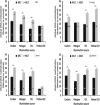Artificial Light at Night of Different Spectral Compositions Differentially Affects Tumor Growth in Mice: Interaction With Melatonin and Epigenetic Pathways
- PMID: 30477310
- PMCID: PMC6259078
- DOI: 10.1177/1073274818812908
Artificial Light at Night of Different Spectral Compositions Differentially Affects Tumor Growth in Mice: Interaction With Melatonin and Epigenetic Pathways
Abstract
Lighting technology is rapidly advancing toward shorter wavelength illuminations that offer energy-efficient properties. Along with this advantage, the increased use of such illuminations also poses some health challenges, particularly breast cancer progression. Here, we evaluated the effects of artificial light at night (ALAN) of 4 different spectral compositions (500-595 nm) at 350 Lux on melatonin suppression by measuring its urine metabolite 6-sulfatoxymelatonin, global DNA methylation, tumor growth, metastases formation, and urinary corticosterone levels in 4T1 breast cancer cell-inoculated female BALB/c mice. The results revealed an inverse dose-dependent relationship between wavelength and melatonin suppression. Short wavelength increased tumor growth, promoted lung metastases formation, and advanced DNA hypomethylation, while long wavelength lessened these effects. Melatonin treatment counteracted these effects and resulted in reduced cancer burden. The wavelength suppression threshold for melatonin-induced tumor growth was 500 nm. These results suggest that short wavelength increases cancer burden by inducing aberrant DNA methylation mediated by the suppression of melatonin. Additionally, melatonin suppression and global DNA methylation are suggested as promising biomarkers for early diagnosis and therapy of breast cancer. Finally, ALAN may manifest other physiological responses such as stress responses that may challenge the survival fitness of the animal under natural environments.
Keywords: 6-SMT; CFL; EE-halogen; GDM-levels; body mass; carbon; corticosterone; cosinor analysis; light at night; yellow-LED.
Conflict of interest statement
Figures







Comment in
-
Melatonin-Deficient Balb/c Mice and Their Use in Cancer Research.Cancer Control. 2019 Jan-Dec;26(1):1073274819886825. doi: 10.1177/1073274819886825. Cancer Control. 2019. PMID: 31718259 Free PMC article. No abstract available.
Similar articles
-
Epigenetic modification in 4T1 mouse breast cancer model by artificial light at night and melatonin - the role of DNA-methyltransferase.Chronobiol Int. 2019 May;36(5):629-643. doi: 10.1080/07420528.2019.1574265. Epub 2019 Feb 12. Chronobiol Int. 2019. PMID: 30746962
-
Light at night and melatonin have opposite effects on breast cancer tumors in mice assessed by growth rates and global DNA methylation.Chronobiol Int. 2014 Feb;31(1):144-50. doi: 10.3109/07420528.2013.842925. Epub 2013 Oct 16. Chronobiol Int. 2014. PMID: 24131150
-
Altered metabolic and hormonal responses in male rats exposed to acute bright light-at-night associated with global DNA hypo-methylation.J Photochem Photobiol B. 2019 May;194:107-118. doi: 10.1016/j.jphotobiol.2019.03.020. Epub 2019 Mar 28. J Photochem Photobiol B. 2019. PMID: 30953912
-
Artificial light at night: melatonin as a mediator between the environment and epigenome.Philos Trans R Soc Lond B Biol Sci. 2015 May 5;370(1667):20140121. doi: 10.1098/rstb.2014.0121. Philos Trans R Soc Lond B Biol Sci. 2015. PMID: 25780234 Free PMC article. Review.
-
Effects of artificial light at night on human health: A literature review of observational and experimental studies applied to exposure assessment.Chronobiol Int. 2015;32(9):1294-310. doi: 10.3109/07420528.2015.1073158. Epub 2015 Sep 16. Chronobiol Int. 2015. PMID: 26375320 Review.
Cited by
-
Potential of Melatonin as Adjuvant Therapy of Oral Cancer in the Era of Epigenomics.Cancers (Basel). 2019 Nov 2;11(11):1712. doi: 10.3390/cancers11111712. Cancers (Basel). 2019. PMID: 31684096 Free PMC article. Review.
-
Insight of Melatonin: The Potential of Melatonin to Treat Bacteria-Induced Mastitis.Antioxidants (Basel). 2022 Jun 2;11(6):1107. doi: 10.3390/antiox11061107. Antioxidants (Basel). 2022. PMID: 35740004 Free PMC article. Review.
-
Environmental Influences on Sleep in the California Teachers Study Cohort.Am J Epidemiol. 2022 Aug 22;191(9):1532-1539. doi: 10.1093/aje/kwab246. Am J Epidemiol. 2022. PMID: 34613370 Free PMC article.
-
Melatonin: A Potential Regulator of DNA Methylation.Antioxidants (Basel). 2023 May 25;12(6):1155. doi: 10.3390/antiox12061155. Antioxidants (Basel). 2023. PMID: 37371885 Free PMC article. Review.
-
Potential of melatonin to reverse epigenetic aberrations in oral cancer: new findings.EXCLI J. 2023 Dec 12;22:1280-1310. doi: 10.17179/excli2023-6624. eCollection 2023. EXCLI J. 2023. PMID: 38234969 Free PMC article. Review.
References
-
- Torre LA, Bray F, Siegel RL, Ferlay J, Lortet-Tieulent J, Jemal A. Global cancer statistics, 2012. CA Cancer J Clin. 2015;65(2):87–108. - PubMed
-
- Touitou Y, Reinberg A, Touitou D. Association between light at night, melatonin secretion, sleep deprivation, and the internal clock: health impacts and mechanisms of circadian disruption. Life Sci. 2017;173:94–106. - PubMed
-
- Cho Y, Ryu SH, Lee BR, Kim KH, Lee E, Choi J. Effects of artificial light at night on human health: a literature review of observational and experimental studies applied to exposure assessment. Chronobiol Int. 2015;32(9):1294–1310. - PubMed
-
- Kloog I, Haim A, Stevens RG, Barchana M, Portnov BA. Light at night co-distributes with incident breast but not lung cancer in the female population of Israel. Chronobiol Int. 2008;25(1):65–81. - PubMed
MeSH terms
Substances
LinkOut - more resources
Full Text Sources
Medical

